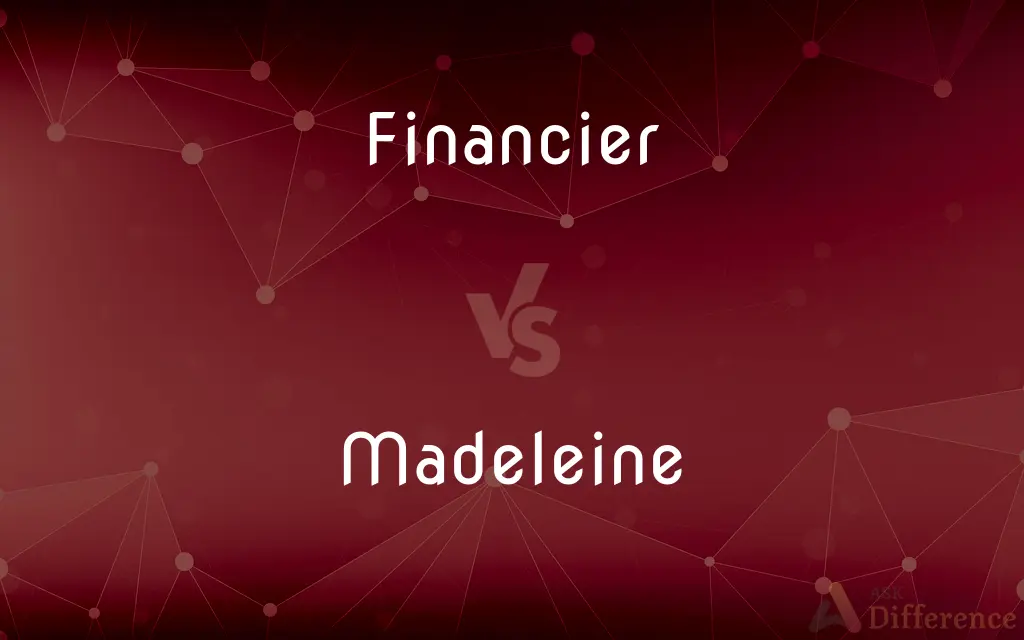Financier vs. Madeleine — What's the Difference?
Edited by Tayyaba Rehman — By Maham Liaqat — Updated on March 25, 2024
A financier is a small French almond cake, characterized by its light and moist texture, while a madeleine is a small sponge cake with a distinctive shell-like shape.

Difference Between Financier and Madeleine
Table of Contents
ADVERTISEMENT
Key Differences
Financiers and madeleines are both celebrated confections originating from France, adored for their delicate flavors and textures, but they differ significantly in ingredients, appearance, and historical background. On the other hand, the madeleine is a small sponge cake with a distinctive shell-like shape, achieved by baking in special pans with shell-shaped depressions.
The financier is a small, often rectangular or lozenge-shaped almond cake, made with almond flour, butter, egg whites, and powdered sugar, leading to a moist, buttery texture with a crisp exterior. It's traditionally baked in molds that resemble gold bars, which is said to be the origin of its name, linking it to the financial district of Paris where it first gained popularity among bankers. Madeleines are characterized by their light, airy texture and are often flavored with lemon zest, giving them a subtly citrus aroma. The batter for madeleines typically includes whole eggs, sugar, flour, melted butter, and sometimes honey, creating a tender crumb and golden-brown exterior.
While financiers are celebrated for their almond flavor and dense yet tender crumb, resulting from the use of almond flour and beurre noisette (brown butter), madeleines are prized for their soft, sponge-like consistency and the delicate flavoring that can range from vanilla to citrus, depending on the recipe. The madeleine's fame was notably boosted by Marcel Proust's "In Search of Lost Time," where he poetically recalls dipping a madeleine in tea, which evokes a flood of memories.
Both pastries require careful preparation and specific molds to achieve their classic shapes and textures, and both have become symbols of French pâtisserie, enjoyed by people all over the world. Whether served at high tea, as a dessert, or a treat to accompany coffee, financiers and madeleines offer distinct and delightful experiences, reflecting the richness of French culinary
Comparison Chart
Shape
Rectangular or lozenge-shaped
Shell-shaped
ADVERTISEMENT
Main Ingredients
Almond flour, egg whites, butter, sugar
Whole eggs, sugar, flour, butter
Texture
Moist and buttery with a crisp exterior
Light, airy, with a tender crumb
Flavor
Almond, due to almond flour and brown butter
Often lemon zest, providing a subtle citrus aroma
Origin
Linked to Paris's financial district
Lorraine region in France
Historical Association
Popular among bankers due to its shape resembling gold bars
Immortalized in literature by Marcel Proust
Serving Occasion
Tea time, dessert, coffee accompaniment
Often served with tea or as a light dessert
Compare with Definitions
Financier
A small French almond cake with a moist texture.
The financier had a perfectly crisp edge, thanks to the almond flour and brown butter.
Madeleine
A small sponge cake with a distinctive shell shape.
She carefully removed the golden-brown madeleines from their shell-shaped molds.
Financier
Known for its rectangular or lozenge shape.
The financiers were arranged on a plate, resembling tiny gold bars.
Madeleine
Light and airy texture.
The madeleines were so light and airy, they practically melted in the mouth.
Financier
Popular among Paris's bankers.
The financier became a quick snack of choice in the bustling financial districts.
Madeleine
A symbol of French pâtisserie.
Madeleines are often cited as a quintessential example of French baking artistry.
Financier
Made with egg whites and almond flour.
She appreciated the lightness the egg whites brought to the financiers.
Madeleine
Celebrated in literature by Marcel Proust.
The memory of his aunt's madeleines dipped in tea became a pivotal moment in literature.
Financier
Served as a sophisticated dessert.
For dessert, they served financiers alongside a selection of French cheeses.
Madeleine
Often flavored with lemon zest.
The hint of lemon zest gave the madeleines a fresh, aromatic quality.
Financier
A person concerned in the management of large amounts of money on behalf of governments or other large organizations.
Madeleine
A small rich cake, baked in a shell-shaped mold.
Financier
One that engages in investing or raising large amounts of money.
Madeleine
A French type of small gateau or sponge cake, often shaped like an elongated scallop shell.
Financier
A person who, as a profession, profits from large financial transactions.
Madeleine
(figuratively) Something which brings back a memory; a source of nostalgia or evocative memories.
Financier
A company that does the same.
Financier
One charged with the administration of finance; an officer who administers the public revenue; a treasurer.
Financier
A light, spongy teacake, usually based on almond flour or flavoring.
Financier
A traditional French (Ragoût a la Financière) or Piemontese (Finanziera alla piemontese) rich sauce or ragout, made with coxcomb, wattles, cock's testicles, chicken livers and a variety of other ingredients.
Financier
(ambitransitive) To carry out financial transactions; to finance something.
Financier
One charged with the administration of finance; an officer who administers the public revenue; a treasurer.
Financier
One skilled in financial operations; one acquainted with money matters.
Financier
To conduct financial operations.
Financier
A person skilled in large scale financial transactions
Financier
Conduct financial operations, often in an unethical manner
Common Curiosities
What makes a financier different from a madeleine?
Financiers are almond-based cakes with a moist, buttery texture, often rectangular-shaped, while madeleines are light, sponge cakes with a shell-like shape, frequently flavored with lemon zest.
Why is the financier named so?
It's believed to be named after the financial district in Paris, as its original shape resembled gold bars, and it was popular among bankers.
Can you use the same mold for financiers and madeleines?
No, financiers and madeleines require different molds to achieve their distinctive shapes—rectangular or lozenge for financiers and shell-shaped for madeleines.
What is the significance of the madeleine in literature?
The madeleine is famously associated with Marcel Proust's "In Search of Lost Time," where it serves as a trigger for the narrator's memories.
Are financiers and madeleines served on the same occasions?
Both can be served at tea time or as desserts, but their unique flavors and textures offer different culinary experiences.
Can financiers and madeleines be made without their specific molds?
While alternative molds can be used, the classic shapes of these pastries contribute to their identity and aesthetic appeal.
How have financiers and madeleines evolved in modern cuisine?
While staying true to their origins, contemporary variations experiment with flavors and presentation, incorporating new ingredients like chocolate, matcha, or orange zest.
What is the key to achieving the perfect texture for each pastry?
For financiers, the use of almond flour and brown butter is crucial, while madeleines rely on the aeration of eggs and careful folding of ingredients to maintain a light, airy texture.
Is one considered more upscale or sophisticated than the other?
Both are regarded as delicacies within French pâtisserie; their sophistication often lies in the skill of their preparation rather than the pastries themselves.
How do the flavors of financiers and madeleines complement different beverages?
Financiers, with their rich almond and butter flavor, pair well with coffee, while the light, citrusy madeleines are a perfect match for tea.
Share Your Discovery

Previous Comparison
Oak vs. Ash
Next Comparison
Friend vs. FriendlyAuthor Spotlight
Written by
Maham LiaqatEdited by
Tayyaba RehmanTayyaba Rehman is a distinguished writer, currently serving as a primary contributor to askdifference.com. As a researcher in semantics and etymology, Tayyaba's passion for the complexity of languages and their distinctions has found a perfect home on the platform. Tayyaba delves into the intricacies of language, distinguishing between commonly confused words and phrases, thereby providing clarity for readers worldwide.















































